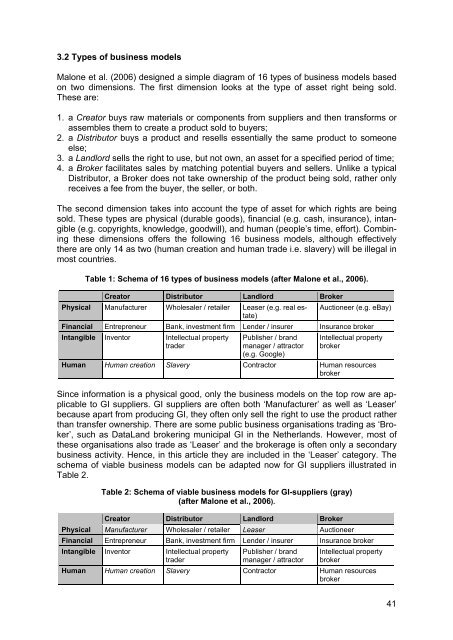SDI Convergence - Global Spatial Data Infrastructure Association
SDI Convergence - Global Spatial Data Infrastructure Association
SDI Convergence - Global Spatial Data Infrastructure Association
You also want an ePaper? Increase the reach of your titles
YUMPU automatically turns print PDFs into web optimized ePapers that Google loves.
3.2 Types of business models<br />
Malone et al. (2006) designed a simple diagram of 16 types of business models based<br />
on two dimensions. The first dimension looks at the type of asset right being sold.<br />
These are:<br />
1. a Creator buys raw materials or components from suppliers and then transforms or<br />
assembles them to create a product sold to buyers;<br />
2. a Distributor buys a product and resells essentially the same product to someone<br />
else;<br />
3. a Landlord sells the right to use, but not own, an asset for a specified period of time;<br />
4. a Broker facilitates sales by matching potential buyers and sellers. Unlike a typical<br />
Distributor, a Broker does not take ownership of the product being sold, rather only<br />
receives a fee from the buyer, the seller, or both.<br />
The second dimension takes into account the type of asset for which rights are being<br />
sold. These types are physical (durable goods), financial (e.g. cash, insurance), intangible<br />
(e.g. copyrights, knowledge, goodwill), and human (people’s time, effort). Combining<br />
these dimensions offers the following 16 business models, although effectively<br />
there are only 14 as two (human creation and human trade i.e. slavery) will be illegal in<br />
most countries.<br />
Table 1: Schema of 16 types of business models (after Malone et al., 2006).<br />
Creator Distributor Landlord Broker<br />
Physical Manufacturer Wholesaler / retailer Leaser (e.g. real estate)<br />
Auctioneer (e.g. eBay)<br />
Financial Entrepreneur Bank, investment firm Lender / insurer Insurance broker<br />
Intangible Inventor Intellectual property Publisher / brand Intellectual property<br />
trader<br />
manager / attractor<br />
(e.g. Google)<br />
broker<br />
Human Human creation Slavery Contractor Human resources<br />
broker<br />
Since information is a physical good, only the business models on the top row are applicable<br />
to GI suppliers. GI suppliers are often both ‘Manufacturer’ as well as ‘Leaser’<br />
because apart from producing GI, they often only sell the right to use the product rather<br />
than transfer ownership. There are some public business organisations trading as ‘Broker’,<br />
such as <strong>Data</strong>Land brokering municipal GI in the Netherlands. However, most of<br />
these organisations also trade as ‘Leaser’ and the brokerage is often only a secondary<br />
business activity. Hence, in this article they are included in the ‘Leaser’ category. The<br />
schema of viable business models can be adapted now for GI suppliers illustrated in<br />
Table 2.<br />
Table 2: Schema of viable business models for GI-suppliers (gray)<br />
(after Malone et al., 2006).<br />
Creator Distributor Landlord Broker<br />
Physical Manufacturer Wholesaler / retailer Leaser Auctioneer<br />
Financial Entrepreneur Bank, investment firm Lender / insurer Insurance broker<br />
Intangible Inventor Intellectual property Publisher / brand Intellectual property<br />
trader<br />
manager / attractor broker<br />
Human Human creation Slavery Contractor Human resources<br />
broker<br />
41

















